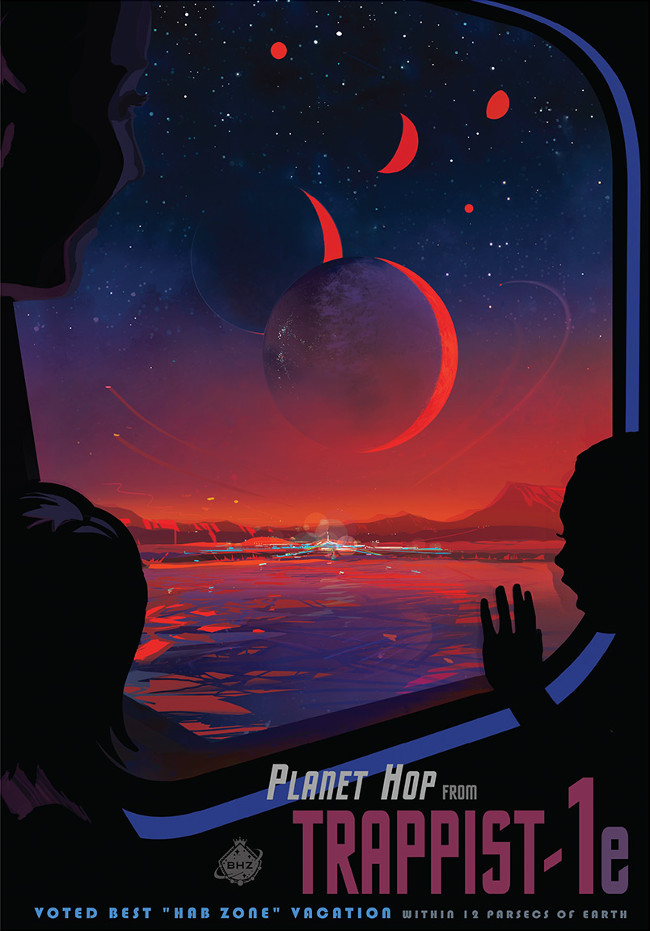Surprise with a strange life on the new solar system discovered
New solar system TRAPPIST-1 that NASA has discovered has 7 planets of the same size as the Earth and has enough temperature for life. So how will life on these planets be different from life on Earth?
The view of the night sky is wonderful
If standing on one of the seven planets of the TRAPPIST-1 system, the most spectacular thing you can enjoy is the image of the six remaining planets in the sky. In some cases, a neighbor planet may be twice as big as the full moon seen from Earth.
Michael Gillon, an astronomer at Liege University in Belgium, said: "You will not see these planets as we see Venus or Mars, which are only light spots in the sky. You will see the planets. Just as we look at the Moon, you will see the structures of these worlds. "

An imaginary journey to TRAPPIST-1.
All 7 planets of the TRAPPIST-1 system orbital close to their host star rather than Mercury orbiting the Sun. The planet at the far end and outermost planet is nearly 30 times more Earth than the distance between Earth and Venus at the farthest distance.
The reason why these seven siblings might orbit around such a narrow orbit is because the host star is a super-cold dwarf. This star is 2,000 times darker than the Sun and just a little bigger than Jupiter.
Three of the TRAPPIST-1 planets orbiting the star are called "habitable regions" , or areas around a star where the planet may have a suitable surface temperature. for liquid water. The location of this habitable area is every other star. With a very dark star like TRAPPIST-1, which emits much less heat than the Sun, the habitable area is much closer to the star.
But there is no guarantee that a planet in the habitable area of TRAPPIST-1 can have liquid water on the surface. For example, on comets, ice directly "sublimates" into a vapor, rather than through a liquid, when heated by the sun.
Always "twilight"
Although the 7 planets of TRAPPIST-1 orbiting extremely close to the host star, natural light on these planets appears to be very weak to humans.
Super-cold dwarfs produce much less heat than stars like the Sun and most of TRAPPIST-1's light is transmitted as infrared wavelengths rather than visible wavelengths.
TRAPPIST-1 will be able to heat the air on the surface of 7 planets but the daylight sky will not be brighter than the sky on Earth after the Sun sets, making the world on this system only dusk with pink orange.

Fanciful life on the new planet.
Short year, endless day
The planets of TRAPPIST-1 hardly take any time to spin around the host star. 6 planets spin a full circle in any position that takes only 1.5 to 12.4 days. The period when the furthest planet orbiting the orbit takes only 20 days.
That means that a "five" on most of these planets is equivalent to less than 2 weeks on Earth.
However, the period of orbiting the orbits of these planets is "disturbed" by neighbors .
According to Sean Carey, director of NASA's Spitzer Science Center in Pasadena, California, at NASA's press conference on February 22: "The planets" pull together "when they turn around the star". Therefore, they change the time around orbit.
Although the year on TRAPPIST-1 is shorter, the day will be very long, almost endless. The reason is that the planets are "tide lock" , meaning that one side of each planet is always facing the host star. The moon is "locked in tidal" to Earth.
Some planets that are "tide locked" can live with life because the opposite side of the star will become extremely hot, while the other side is extremely cold.
However, some models show that the planet's atmosphere can absorb heat on the surface of the planet, so that life can survive.
- Discover the oldest solar system outside the solar system
- Life has spread throughout the solar system
- The largest solar system outside the solar system revolves around two stars
- NASA discovered more than 100 planets outside the Solar System
- The fake life in the solar system has 2 suns?
- The new model quickly identifies life outside the solar system
- How long does it take to get up to 7 life-capable planets - has Trappist-1 been discovered?
- Discovered 'super-Saturn' outside the Solar System
- Discovery of the baby solar system record
- Discover more than 700 planets outside the solar system
- NASA press conference: We have a perfect 2 Solar System for extraterrestrial life
- Found the Solar System miniature
 Van Allen's belt and evidence that the Apollo 11 mission to the Moon was myth
Van Allen's belt and evidence that the Apollo 11 mission to the Moon was myth The levels of civilization in the universe (Kardashev scale)
The levels of civilization in the universe (Kardashev scale) Today Mars, the sun and the Earth are aligned
Today Mars, the sun and the Earth are aligned The Amazon owner announced a secret plan to build a space base for thousands of people
The Amazon owner announced a secret plan to build a space base for thousands of people